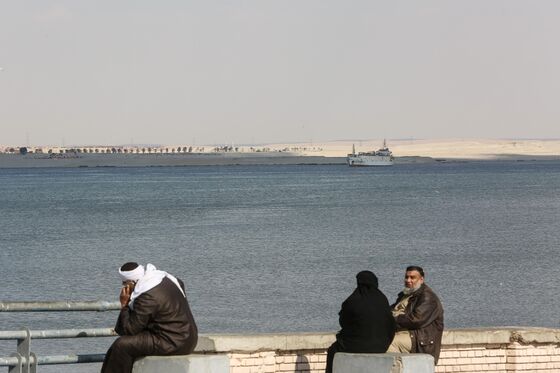Why a Canal Built in 1869 Is More Important Than Ever
What Is the Suez Canal and Why Is It So Important?
(Bloomberg) -- The Suez Canal, which cuts through Egypt to connect the Mediterranean and Red seas, is so important to world trade that world powers have fought over it since it was completed in 1869. That strategic shipping lane was completely blocked on March 23, when the heavily laden cargo ship Ever Given, longer than the Eiffel Tower is tall, went askew in heavy winds and got its bow wedged into the side of the waterway. The mishap snarled international shipping amid efforts by elite teams to refloat the massive vessel.
1. What’s the Suez Canal?
The 193 kilometer (120 mile) man-made waterway cuts through Egypt to connect the Mediterranean Sea to the Red Sea, and by extension the Atlantic and Indian oceans. That makes it a key transit point for ships moving goods between Asia and Europe and the eastern U.S. It entered service in 1869, 45 years before the Panama Canal, which is much shorter, linking the Pacific and Atlantic oceans. The sea-level canal is the longest in the world without locks, with a normal transit time from end to end of about 13-15 hours, according to GlobalSecurity.org.

2. Why is it so important?
About 12% of world trade passes through the canal each year, everything from crude oil to grains to instant coffee. Without Suez, a supertanker carrying Mideast crude oil to Europe would have to travel an extra 6,000 miles around Africa’s Cape of Good Hope, adding some $300,000 in fuel costs (although there would be savings from avoiding the Suez passage tolls, which can run hundreds of thousands of dollars.) Because it has no locks, it can even handle aircraft carriers.
3. What travels through it?
Just about every good imaginable, adding up in 2019 to 1.03 billion tons of cargo, according to the Suez Canal Authority. That’s roughly four times more than passed through the Panama Canal. The canal’s location makes it a key link for shipping crude oil and other hydrocarbons from countries such as Saudi Arabia to Europe and North America. Among other goods, 54.1 million tons of cereal passed through the canal, 53.5 million tons of ores and metals and 35.4 million tons of coal and coke in 2019.

4. What are the origins of the canal?
The idea dates back to antiquity but it wasn’t until the mid 19th century that Egypt’s Ottoman viceroy Said Pasha granted a French company a concession to build the canal. The project took 10 years and some 1.5 million laborers and cost $100 million ($1.9 billion today), twice the initial estimate. The canal entered service in 1869 but its owners faced financial difficulties shortly after and were forced to sell a controlling stake to the U.K., which ran the canal for the next eight decades.
5. Who owns it today?
Egypt’s anti-colonial President Gamal Abdel Nasser nationalized the canal in 1956, a move that sparked the Suez Crisis that same year when Israeli, British and France forces staged an invasion of the Sinai and canal zone. The crisis, which ended after the U.S. intervened against the invasion, resulted in the canal’s closure for a year. (It also saw the first UN peacekeeping force.) A decade later, the 1967 Israeli-Arab war prompted Egypt to close Suez to ship traffic for eight years as Egyptian and Israeli forces faced off across the water. Today, the canal is operated by the state-owned Suez Canal Authority and is a major money-earner for Egypt’s government, generating $5.61 billion in revenue last year. An $8 billion expansion of the canal was launched in 2015 with the goal of increasing ship traffic and more than doubling revenue.

The Reference Shelf
- Bloomberg Opinion’s David Fickling and Anjani Trivedi call the Suez closure a foretaste of new Cold War crises.
- History.org’s topic page on the canal’s construction.
- The Suez Canal Authority’s own website.
- The time 14 cargo ships were stuck on the canal for eight years.
- NASA’s Earth Observatory looked at the canal expansion from above.
- A QuickTake on another shipping chokepoint, the Strait of Hormuz.
©2021 Bloomberg L.P.